Petechiae refer to small, reddish round blotches on the leg. Know all about the causes, symptoms, diagnosis and treatment of Petechiae. You can also have a look at some useful pictures of Petechiae.
Petechiae Definition
Page Contents
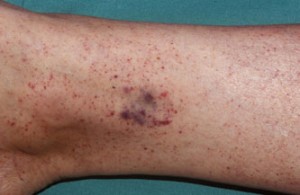
Picture 1 – Petechiae
Source – calicutmedicaljournal
It is a singular medical condition that gives rise to small red spots over the skin of the leg. A single blotch is referred to as Petechia. A group of blotches of this type is called Petechiae.
Petechiae Color
When Petechia rashes appear first, they are red in color. Gradually, they turn purple or bluish in color. In the final stages, they are dark blue or dark purple in appearance.
Petechiae Size
Individually, these spots are one to two mm in size. These are less than 0.5 cm even in the later stages of the disease. At any stage, they do not have a diameter of more than 3 mm.
Petechiae Location
These rashes usually arise on the surface of the legs. In the later stages however, they may be found in many other areas of the body such as shoulder, back, thigh and ankles.
Facial Petechiae
It is a Petechiae type that leads to the formation of reddish spots over the face. Petechiae on face particularly arise in the region surrounding the eyes. This condition may arise due to vomiting, crying or coughing violently.
Palatal Petechiae
This refers to Petechiae spots arising on the palate of a person. It is generally supposed to be a result of Streptococcal bacterial infection. These blothes may also be accompanied by Rubella, Infectious Mononucleosis, Viral Hemorrhagic Fevers, Palatal Trauma, Thrombocytopenia and Roseola.
Petechiae Symptoms
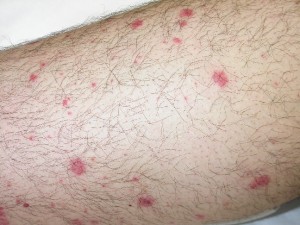
Picture 2 – Petechiae Photo
Source – ucsf.edu
Some of the main symptoms of Petechiae are
Skin Spots – Development of reddish spots over the skin surface on the legs is the main symptom of this condition. These are flat in appearance and not elevated like rashes. The flatness of these spots is due to the fact that they are formed under the surface of the skin. The spots, unlike other rashes, do not blanch when pressed upon.
Change of Color – The skin spots change color from red to brown and finally to purple. The blotches may sometimes appear brown or dark purple because of oxidation of blood.
Clustering of Spots – The blotches appear individually in the initial stages. As more spots of similar type appear, these get clustered together.
What Causes Petechiae?
Petechiae rashes may arise due to a number of factors. Some of the main causes of Petechiae are
Trauma – Petechia spots arise more frequently due to trauma on the skin than any other reason.
Pressure – Applying excessive pressure on a body tissue may also give rise to these spots. Tightly wrapping compression bandage around a part of the body can also cause these blotches.
Hemorrhage – When the capillary vessels of the skin suffer an injury, it may lead to hemorrhage. Red blood may leak from the capillaries but get accumulated under the skin due to the absence of any cut or opening under the surface.
Allergy – Certain medications produce allergenic reactions in the body and give rise to Petechiae spots.
Fever – People suffering from fever are often seen to develop these splotches. This usually occurs when Meningococcus bacterium is present in the bloodstream.
Thrombocytopenia – This disease arises due to low platelet count in the body. It generally occurs as a side effect of medicine intake or when the person suffers from an infection. The function of platelets gets impaired and this results in Petechiae.
Leukemia – Life-threatening disorders such as bone marrow cancers and Leukemia can result in low platelet count and become one of the major Petechiae causes.
Medicines – This skin condition may also arise as a side effect of drugs like Heparin, Aspirin, Warfarin and Cortisone. It can also occur as an adverse effect of Chemotherapy and Radiation.
Autoimmune Diseases – An autoimmune disorder can prompt a natural response from the immune system of the body. The body starts producing antibodies that attack the tissues and other natural organs wrongly perceiving them as foreign objects. This may result in damage of tissues and cause blood leakage.
Viral Infections – Viral infection of the body may also result in defective blood clotting and lead to the development of these spots.
Petechiae Differential Diagnosis
The differential diagnosis for Petechiae involves distinguishing the disease from other similar conditions like
- Purpura
- Hypersensitivity angiitis
- Rickettsialpox
- Scurvy
- Wiskott-Aldrich syndrome
- Thrombocytopenia
- Petechiae
Petechiae Treatment
Petechiae cure is usually done by treating any underlying condition responsible for the blotches. This is carried out by
Stopping Medication – If an allergic reaction from a medicine is found to be the cause, stopping the dosage immediately is the easiest option.
Ice Application – If these spots are the result of injuries to blood capillaries, applying ice packs over the affected area may cure the condition. It is recommended that you place a paper towel between the ice pack and the skin to avoid damaging the surface.
Antibiotics – Antibiotic medication is generally recommended if an infectious condition is the cause of the spots.
Surgery – If in Petechiae Leukemia or malignant conditions like Cancer are found to be responsible factors, a surgical operation may become necessary.
Platelet Transfusion – If low platelet count is the cause of Petechiae on legs, platelet transfusion may help cure the condition.
Petechiae or Purpura
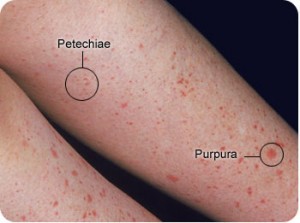
Picture 3 – Difference Between Petechiae and Purpura
Source – lowplatelets
It is often difficult to understand whether tiny red spots arising on skin surface are Petechiae or Purpura. However, Petechiae spots have a very small diameter that is maximum 3 mm in size. Purpura rashes, on the other hand, are larger in size. These have a diameter that is about 5 mm. A spot that is bigger than Purpura is known as common bruise or Ecchymosis.
Petechiae Pictures
Want to know how Petechiae spots look like? Here are some Petechiae photos that you may find useful for your purpose. Take a look at these Petechiae images.
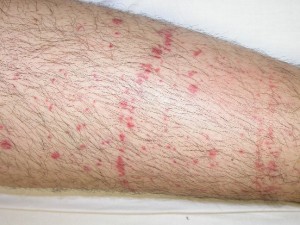
Image 4 – Photo of Petechiae
Source – ucsf.edu
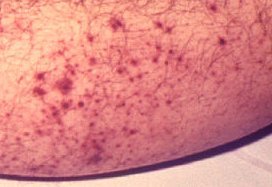
Image 5 – Picture of Petechiae
Source – iknow2.net
With proper treatment, Petechiae can be cured quite fast. If you notice spots similar to this condition on your body, do not delay treatment. Early diagnosis and treatment will get you cured much faster from this discomforting condition.
References:
http://www.bettermedicine.com/article/petechiae
http://en.diagnosispro.com/differential_diagnosis-for/petechiae-petechial-rash/33826-154.html
http://skin-care-at-home.com/blog/tag/petechiae-symptoms
http://www.wisegeek.com/what-is-petechiae.htm
http://en.wikipedia.org/wiki/Petechia

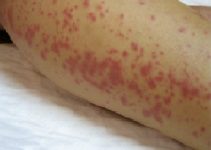
I have petechiae & purpura as a result of SLE. I don’t see lupus as of a result of this “rash.” Why is this? The pics look the same as what I have. Please advice. Thanks
I have lupus also and I have this condition on my face how do I stop this
The stated autoimmune as a cause. That would include SLE/ Lupus
Excellent write-up. I absolutely love this site.
Stick with it!
I have big splothes on my arms and dr says nothing to worry about . I just have thin skinl
how can I print a copy of this article to share with my wound Dr. ?
Excellent post but I was wondering if you could write a litte more on this topic?
I’d be very grateful if you could elaborate a little bit further.
Bless you!
So recently diagnosed with psoriasis, then proceeded to acquire Petechiae on both ankle . .???? OMG incredibly itchy